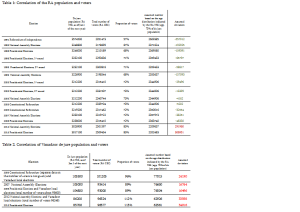Manipulation with the Number of Voters in Electoral Processes
16:22, October 29, 2015 | News, Own news | Electoral RightsAccording to the RA National Statistical Service (RA NSS), the number of population in the Republic of Armenia in 1991 was 3 512 000, of which 58 % (2 051 473) had the right to vote, i.e. legally capable people who had reached the age of 18. Probably due to the absence of joint and systematic voter lists and vagueness of registration mechanisms, there were numerous omissions in the voter lists and a large number of people were deprived of the right to vote in 1990s. Regulation of this issue overtime has, however, brought to the other extreme. In 2013, The RA population was 3 017 100 and the number of voters was 2 509 434 or 83% of the population: Hence in the last 22 years, the RA population has decreased by 500 000, while the number of voters has increased by the same amount (See Table 1). Meanwhile judging from the average age distribution of the RA NSS, 25-30 % of de jure population was under the age of 18. Hence, 70-75% (73 % on average) of de jure population would have been voters. While in reality, the proportion of voters has increased disproportionately in the population, which, if true, means that there was an unprecedented rise in births during the first few years of Armenia’s independence and particularly, during the Nagorno Karabakh Conflict and then has decreased sharply.
At the same time, the comparison of population of Vanadzor and the number of voters shows that this disproportionate increase of the number of voters is a result of artificial intervention or manipulation with numbers.
Thus:
According to the results of 2001 population census, the actual population of Vanadzor was 93 823, while the de jure population was 107 394. According to 2011 population census, the actual population was 82 327, while the de jure population was 86 199. Hence the number of Vanadzor voters in 2001 should have been 75 000 to 80 000, and the number of voters in 2011 should have been 60 000 to 65 000.
According to the data on the officall website of the Central Electoral Commission, the total number of Vanadzor voters in 2005 was 101 205. Meanwhile, the number of de jure population in 2005 was 105 700, i. e. 96 % of the population had the right to vote.
Parallel to the decrease of population in 2012-2013, the number of voters increased. As a results of this, Vanadzor voters comprise 112-113 % of de jure population, which is 34 000 or 50 % higher then the assumed number (See Table 2).
Considering the fact that the number of schoolchildren (who eventually become voters) in Vanadzor schools has decreased by 43 % (See HCA Vanadzor Report on “Assessment of Effectiveness Vanadzor LSG governanece in 2008-2012”), it is obvious that the number of voters should have decreased over the years, while the increase of the number of voters in this light is illogical. Moreover, this increase testifies of intentional fabrication of statistical data, which is a criminally punishable act.

